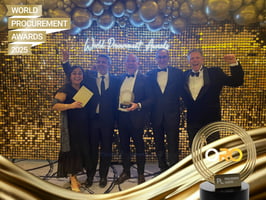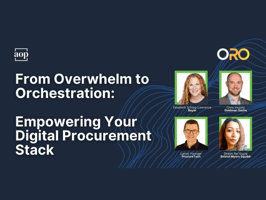To paraphrase Mugatu from the movie Zoolander: “Intake and orchestration. So hot right now!”
Humanize your Frankenstack with Intake Management

Remember the story of Frankenstein’s monster? In the novel by Mary Shelley, Victor Frankenstein assembles his creation from old body parts and weird chemicals. The result was a massive creature with enormous strength. It had a grotesque appearance but the mind of a child. Initially kind and gentle, the monster was shunned by society and, as a result, transformed from something with the potential for tremendous benefit into something terribly destructive.
In large global enterprises, rapid innovation and the proliferation of incredible best-of-breed tools have resulted in ‘Frankenstacks.’ Like Dr. Frankenstein, procurement departments have cobbled together various tools to support their processes and decision-making. Individually, these tools are incredibly powerful, automating previously onerous and error-prone tasks like risk scoring, contract management, ESG assessments, accounting, budgeting and planning, and catalogs. Even as organizations can automate more and more at the task-level, however, they have also introduced significant complexity at the process-level. And this complexity is nowhere more apparent than in the experience of end users. All of this technology may be great for procurement, but it’s confusing to navigate – monstrous, even – for occasional requestors.
The Importance of User Experience
Frankenstacks are powerful, but they are also ugly and unfamiliar. It’s no surprise, then, to see business users do everything they can to avoid working with procurement. According to research from The Hackett Group, the leading cause of maverick spend is a lack of intuitive self-service tools.
Poor user experience is the root cause of many of today’s procurement challenges. According to Hackett’s 2023 Procurement Benchmark study, it takes nearly a month for most organizations to create a purchase order once a request has been made. When only 26% of transactions are touchless, lengthy cycle times and poor satisfaction rates among business users should come as no surprise. Compare this to what Hackett sees among organizations that it terms ‘Digital World Class:’
- 11 day cycle time from requisition to PO
- 77% of transactions are ‘touchless’
- 100% of stakeholders believe that procurement has met or exceeded expectations.
What is Intake Management?
The best definition of Intake Management that I’ve seen is from Gartner. To paraphrase, intake management software improves end-user experiences by helping users navigate pre-configured process workflows such as initiating, routing, and tracking the status of procurement requests in a hybrid application ecosystem.
In other words, intake management in procurement consists of the following elements:
- Procurement Orchestration. Intake management is not just a form for collecting information. It is a process that involves coordinating numerous teams, systems, and sub-processes.
- Universal front door. Users need a single place to go for all of their procurement requests. This includes requisitioning, but it also includes requests for information, supplier updates, risk assessments, and many other procurement processes.
- User experience. Intake management exists to improve the experience of end users by ensuring that workflows are as intuitive as possible. The gold standard for any procurement intake experience is something that is completely self-service and that is so intuitive that no training or documentation is required before someone can make a request.
- Transparency. Black holes begin to appear whenever a process involves steps that take place outside of, or between, technologies. Because intake management is an orchestrated process, procurement achieves full visibility across the entire process lifecycle, and users are given self-service access to view the complete process, understand where their request is in that process, and see an estimated time for completion.
Evaluating Intake Management Tools
When evaluating intake management solutions, it’s important to ask the following questions:
- Does it actually do intake management? Remember what intake management solutions do and require. Specifically, does the solution orchestrate the process from beginning to end across multiple tools? If it’s just a form, or if its primary purpose is to help users navigate processes between modules in a suite (instead of integrating across multiple tools), it might be doing a kind of intake, but it's not doing intake management.
- Can it orchestrate any process? Intake management is a procurement process. But it's not the only procurement process. Just because a solution does intake management does not mean that it can also orchestrate things like supplier onboarding and management, and it doesn’t mean that it can orchestrate sophisticated risk management workflows. To future-proof your investment, make sure that you are investing in an orchestration tool that does intake management and not a tool that only supports intake.
- Does it play favorites? A true intake management tool should function, in a way, like a fiduciary. It should allow organizations to adopt the systems and tools that are best for them today, and provide them with the flexibility they need to add or change over time without significant disruption to user experiences.
Why ORO?
ORO is a GenAI procurement orchestration platform that coordinates processes, tools, and teams so that organizations get what they need without frustration. ORO was recently recognized by Gartner as one of a small number of solutions that do both intake management and procurement orchestration more generally. Importantly, we help organizations avoid vendor lock-in because our market-leading integration platform allows companies to integrate deeply with any ERP, S2P suite, or best-of-breed tool in addition to legacy and homegrown solutions. ORO was built for the enterprise and was the first in the world to earn an accredited ISO 42001 certification for responsible AI.
From the perspective of intake management, ORO provides employees with a unified procurement front door that uses GenAI to support natural language intake, smart form auto-complete, and buying category detection. ORO was founded in order to provide exceptional user experiences, which is why our intuitive workflows do not require any training, and only ask requestors for information that is necessary and that is not already found in other systems. We deliver AI-powered supplier recommendations and unified, multi-channel collaboration tools so people can work how and where they work best. Lastly, ORO delivers full process transparency and compliance measures including supplier pre-checks, contextual supplier records, and self-service process tracking.
Frankenstein’s monster wasn’t bad. But he appeared bad in ways that negatively impacted his experience with other people. Frankenstacks are similar. They are not bad. The fact that procurement has so many options and best-of-breed solutions available to them means that they can fit technology to their needs in ways that were previously impossible. However, the absence of an orchestration solution like ORO to mediate relationships between people, processes, and tools significantly restricts procurement’s ability to extract value from their complex procuretech ecosystems. With ORO for intake management, frankenstacks are humanized, experiences become effortless, the potential of existing technology investments is unlocked, and organizations become more agile in response to change.
Want to learn more about how ORO can help you with your frankenstack? Request a demo today.




